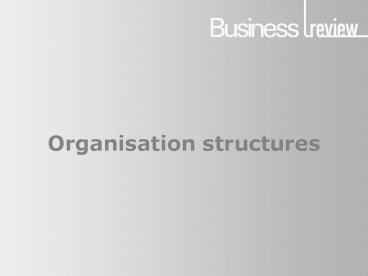Organisation structures - PowerPoint PPT Presentation
1 / 16
Title:
Organisation structures
Description:
Title: Presentation title Author: Stone Last modified by: Ollie Judkins Created Date: 5/20/2006 11:25:11 AM Document presentation format: On-screen Show (4:3) – PowerPoint PPT presentation
Number of Views:36
Avg rating:3.0/5.0
Title: Organisation structures
1
Organisation structures
2
Formal organisation
- This is the internal structure of a business
the way in which human resources are organised.
It takes into account - the relationships between individuals
- who is in charge
- who has authority to make decisions
- who carries out decisions
- how information is communicate
3
Span of control
- The number of people who directly report to one
manager in a hierarchy. - The more people under the control of one manager,
the wider the span of control. - Less people means a narrower span of control.
- The example below would have a span of control of
four people.
4
Chain of command
- Line in which orders and decisions are passed
down from the top of the hierarchy to the bottom
e.g.
5
Flat structures (1)
- These have a few layers and a wider span of
control. - Advantages
- Vertical communication is often quicker.
- It costs less money to run a wider span of
control because a business does not need to
employ as many managers on higher salaries. - Workers are more motivated as they benefit from
job enrichment.
6
Flat structures (2)
- Disadvantages
- Not much opportunity for promotion. Workers will
receive the skills required for these managerial
positions but will get frustrated with the
promotional opportunities available, which can
lead to a high labour turnover. - Difficult and time consuming for managers to
control so many workers.
7
Tall structures (1)
- Lots of layers and often a narrow span of
control. - Advantages
- More opportunity for promotion, as more layers
within the business. - Quicker horizontal communication.
- Closer supervision of workers and fewer mistakes.
8
Tall structures (2)
- Disadvantages
- Vertical communication can become difficult and
lead to poor motivation of subordinates. - Costly, as there are lots of managers.
- Poor motivation, as little delegation occurs.
9
Delegation
- To give somebody the authority to perform a
particular task. - It is important to note that it is the authority
to do the task that is delegated and not the
final responsibility, i.e. if the job is done
badly the manager will still need to accept
responsibility. - Student question
- How does delegation link to leadership styles?
10
Business structures (1)
- Centralisation
- Managers keep control.
- Simple to understand.
- Not much responsibility for staff but fewer
mistakes. - Costs can be cut by standardising purchasing
etc. - Strong leadership.
11
Business structures (2)
- Decentralisation
- Empowering and motivating.
- Freeing up senior managers time.
- Better knowledge of those closer to customers.
- Good staff development.
12
Types of business structure
- Entrepreneurial decisions made centrally.
- Pyramid/hierarchical staff have a role shared
decision making specialisation is possible. - Matrix staff with specific skills join project
teams individuals have responsibility. - Independent seen in professions where
organisation provides support systems and little
else.
13
Entrepreneurial
Few decisions made collectively
Key worker
Key worker
Decisions can be made quickly in this structure
All decisions made centrally
Decision maker
Great reliance on key workers supporting decision
makers
Key worker
Key worker
14
Pyramid
Decisions pass down from managers to staff
Information flows up from staff to management
Decision making is shared throughout the business
This is the traditional structure there is
specialisation of tasks e.g. finance, production,
sales, marketing etc.
15
Matrix
Emphasises getting people with specialist skills
together into project teams. Individuals within
the team have their own responsibilities.
Supports Theory Y type managers.
Marketing
Production
Finance
Project A
Project teams created
Staff with specialist skills
Project B
Workers are organised based on their expertise
16
Matrix vs pyramid
- Matrix is the best way of organising people, as
it is based on skills and expertise. - Matrix gives more delegation.
- Matrix fits in with theory Y managers
- Pyramid is argued to be more theory X.
- Matrix needs expensive support systems. It is
costly to run separate project teams. - Might be difficult to coordinate teams from
different departments. - Evaluation it often depends on the business e.g.
matrix structure complements a magazine business,
might not be ideal in a clothes factory.

